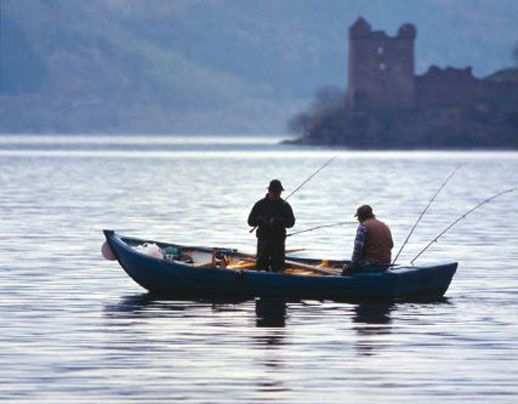If the X-Files was ever filmed at Loch Ness, the TV show’s catchphrase would never be truer … The Truth is Out There! But fact is often stranger than fiction and Nessie is not the only monster who so far has got away. That is, if you listen to some of the tales told on the shores of the loch.
If you happen to see a man with his empty hands as wide apart as he can reach, he may well be recounting a story of the latest Loch Ness Monster sighting. Or it could be Salvelinus alpinus that’s slipped his grasp rather than Nessiteras Rhombopteryx (based on the Greek meaning “the monster of Ness with the diamond shaped fin” and created by naturalist and artist Sir Peter Scott in 1975).
There are many creatures in the dark, deep Highland waters of Loch Ness. And Salvelinus alpinus – otherwise known as the Arctic char – has survived since the last Ice Age.
It is a relative of the salmon and trout but more attractive, with a scarlet belly, purple back and pink spots with white edged fins. It’s beautiful to see and delicious to eat.
There are many fish that live within Loch Ness and travel through it. That’s not surprising when you consider the loch is approximately 23 miles long, with a surface area 52 feet above sea level. It is connected at its southern end by the River Oich and the Caledonian Canal and, at the northern end, through the Bona Narrows to Loch Dochfour then into the River Ness, a route from Dochgarroch that we sail in the summer.
The loch’s depth is often disputed but certainly is as deep as 750 feet and it has the second largest surface area of any loch in Scotland. Our own skipper, Keith, recorded a depth of over 880 feet but this has been disputed as a sonar anomaly – another mystery unfolding! It is also the second deepest loch in Scotland next to Loch Morar.
Since we have the latest technology on board, it is worth coming cruising on Loch Ness with us to see for yourself.
The most famous fish that inhabits the loch is the Atlantic salmon – Salmo salar. It comes to the loch to spawn in the rivers that feed Loch Ness. After the salmon have hatched, they stay until they are two years old as salmon parr then turn into smolts and head back to sea to start the cycle over again.
By law with a permit, you can fish in the loch for salmon from January until October but the Fisheries Board operate a catch-and-release programme. Salmon of over 20 pounds in weight are regularly caught.
There is also the sea trout – Salmo trutta – and the brown trout – Salmo trutta. The sea trout has gone through the river to sea and returned. Brown trout are very common and no licence is needed to fish for them and some can be easily caught from the shore.
There is also another kind of trout in the loch known as a ferox trout – Salmo ferox. It is an ugly looking creature, which can grow quite big, with a large head and under lip. The ferox trout lives on other fish and the Arctic char is its preference. One of over 30 pounds was caught in Loch Awe, in Argyll.
Perfect breeding ground for Ice Age creature
The next species is “Anguilla anguilla” or better known as the eel. They live in Loch Ness in great numbers and some have said that Nessie herself is a very large eel. It has been suggested the waters coming out of the power station at Foyers is an excellent source of nutrients to encourage the growth.
Although the European Eel can grow to over six feet, none of that size have been reported or caught in Loch Ness. Another addition to the mysteries of Loch Ness.
Other fish that can be found here are northern pike – Esox Lucius – stickleback – Gasterosteus aculeatus – and the European minnow – Phoxinus phoxinus.
However, everyone’s favourite is the magnificent Arctic char. Interestingly, it is unable to raise eggs in water that does not drop below 8 degrees centigrade.
That is why Loch Ness is a perfect breeding ground for a creature left over from the Ice Age. Hmmm? The Truth is Out There …


